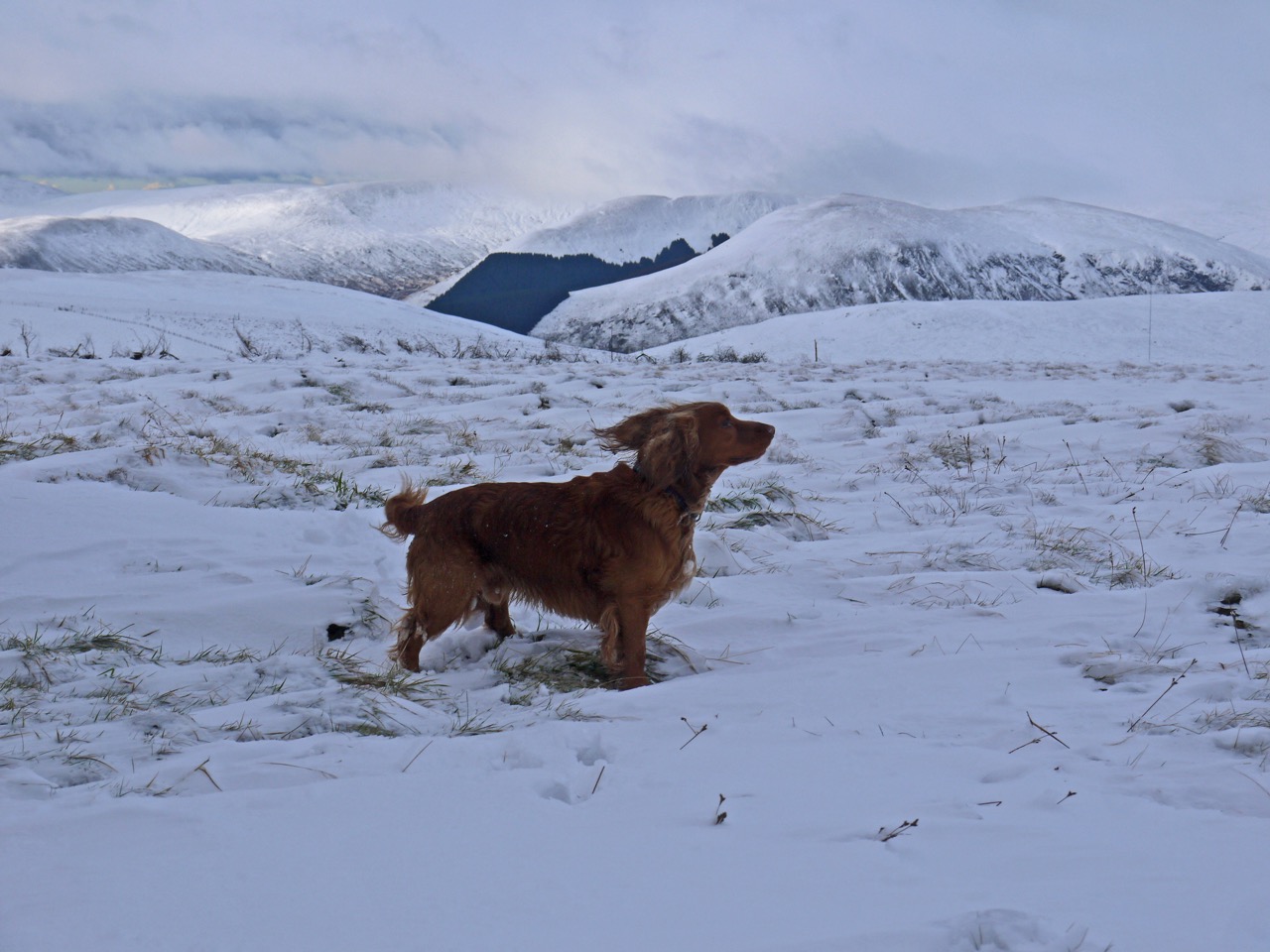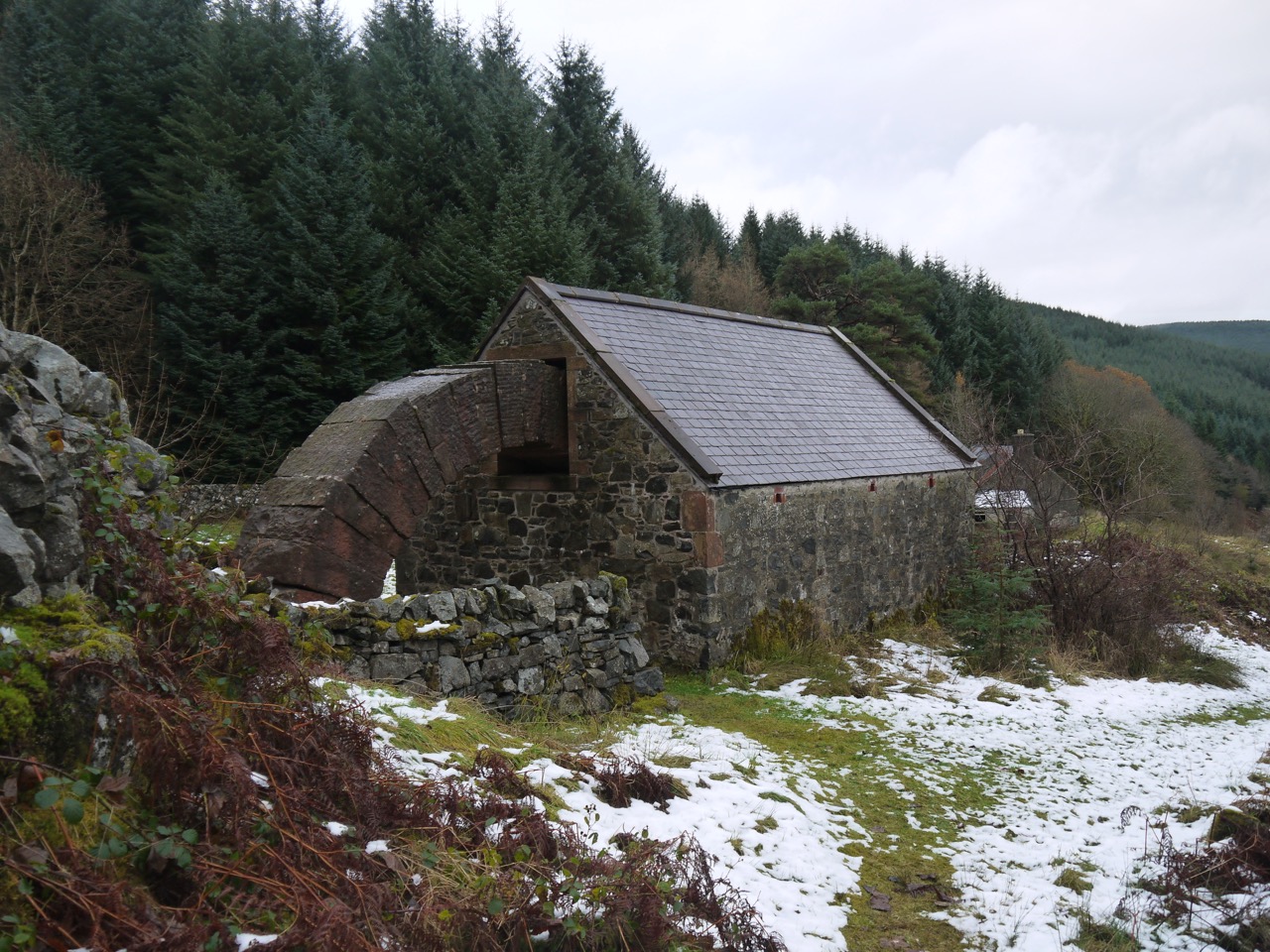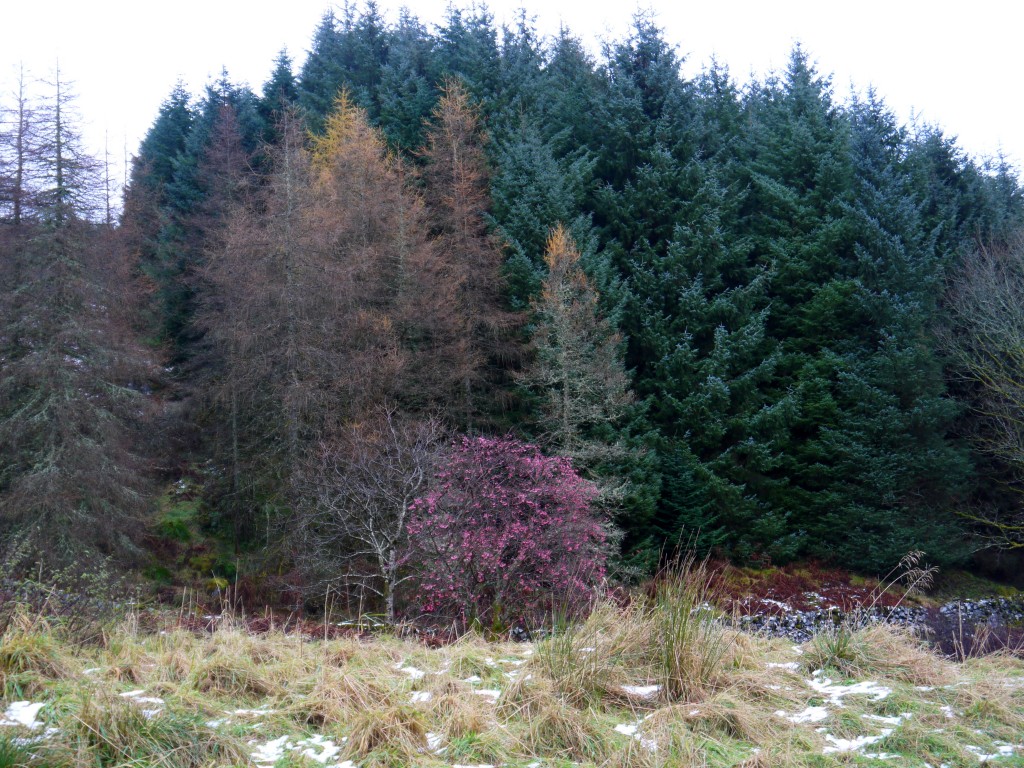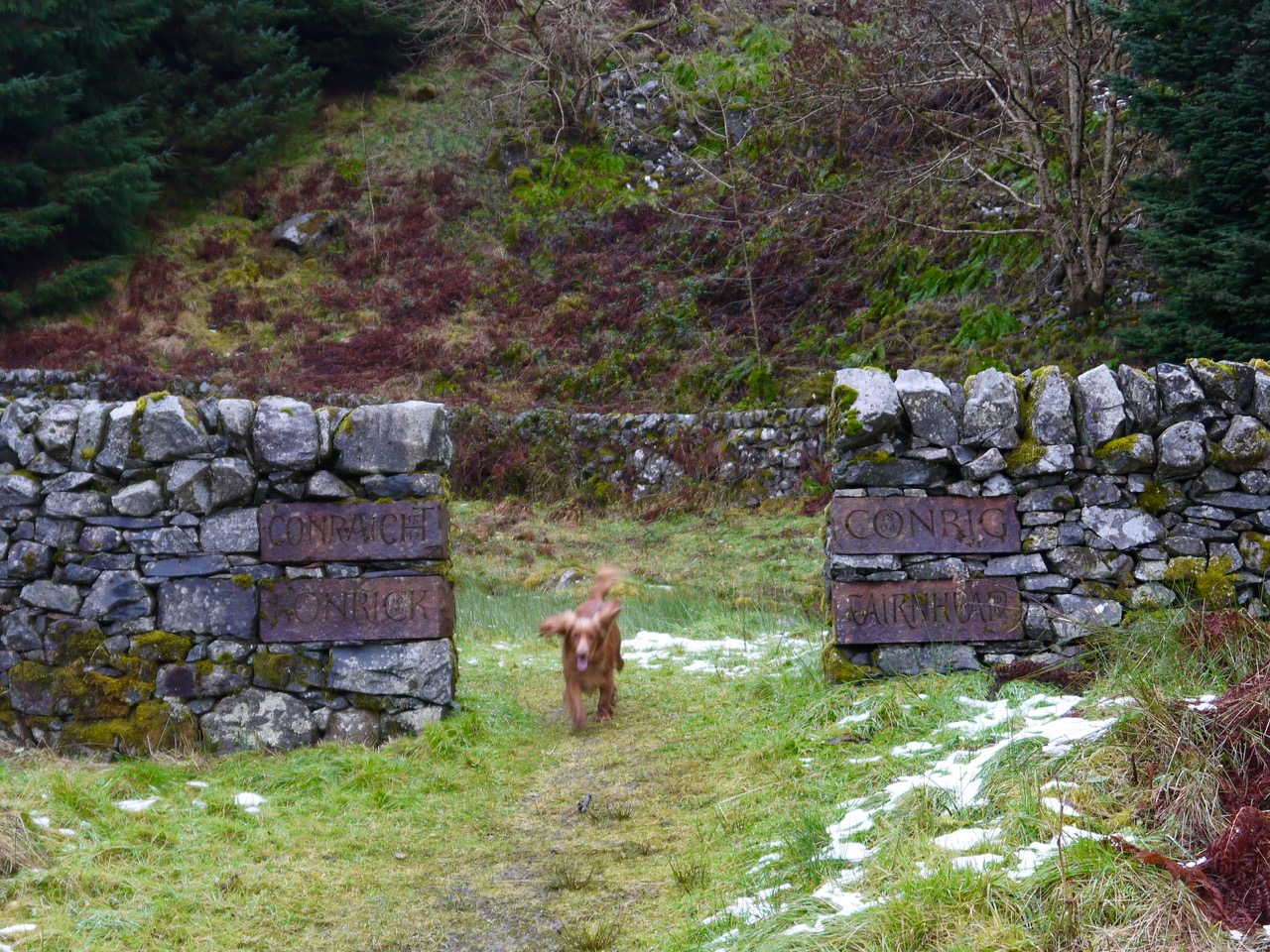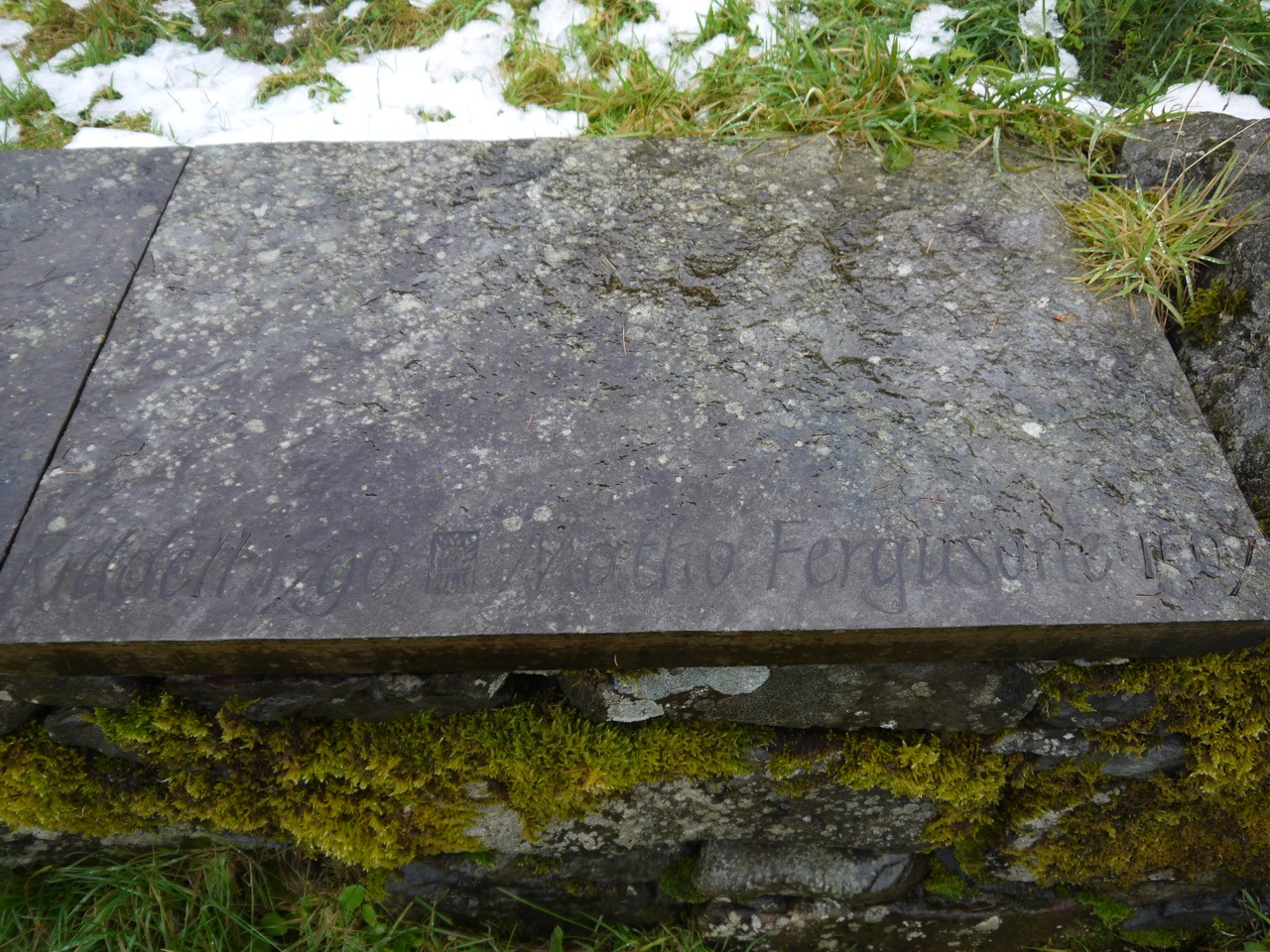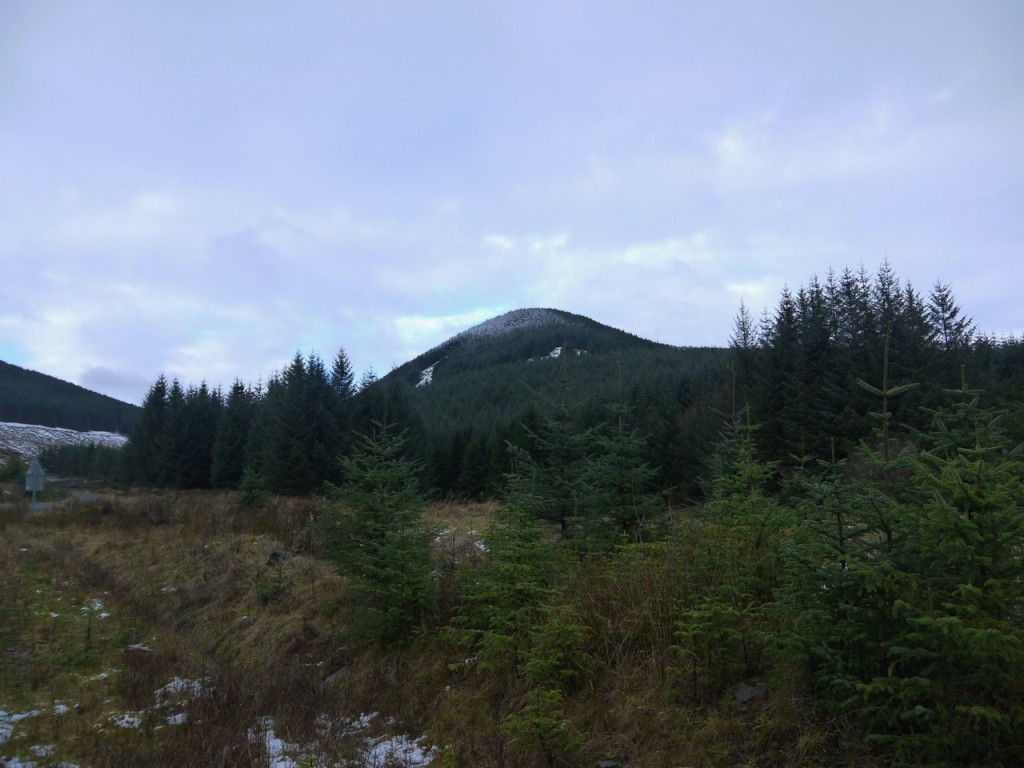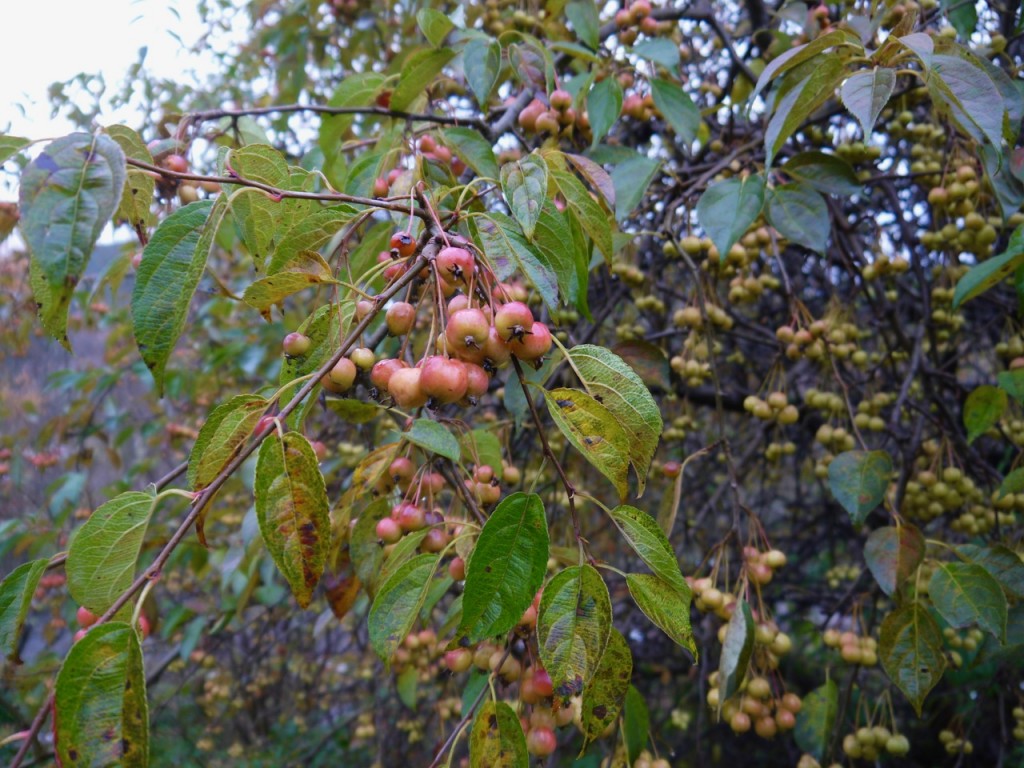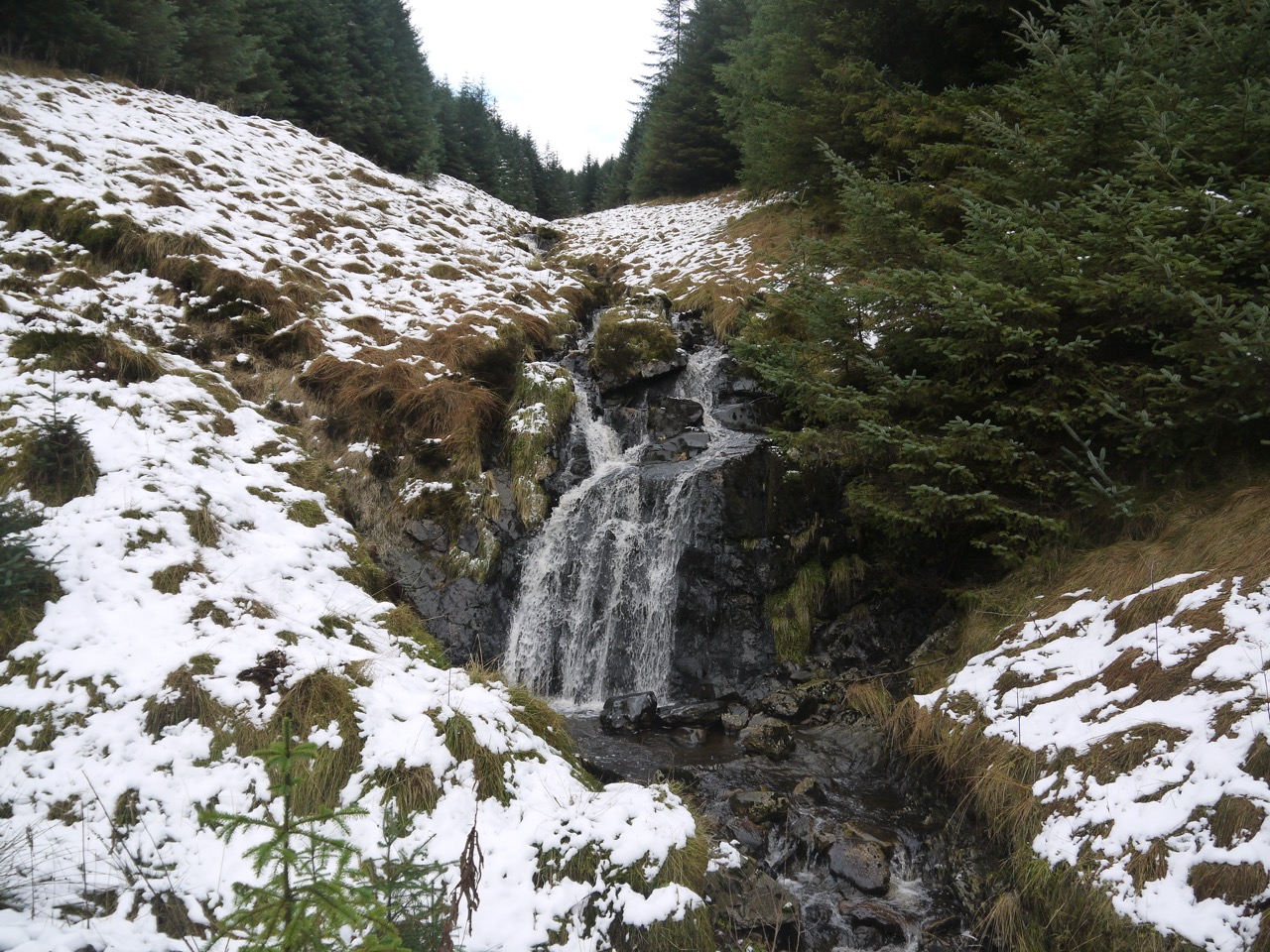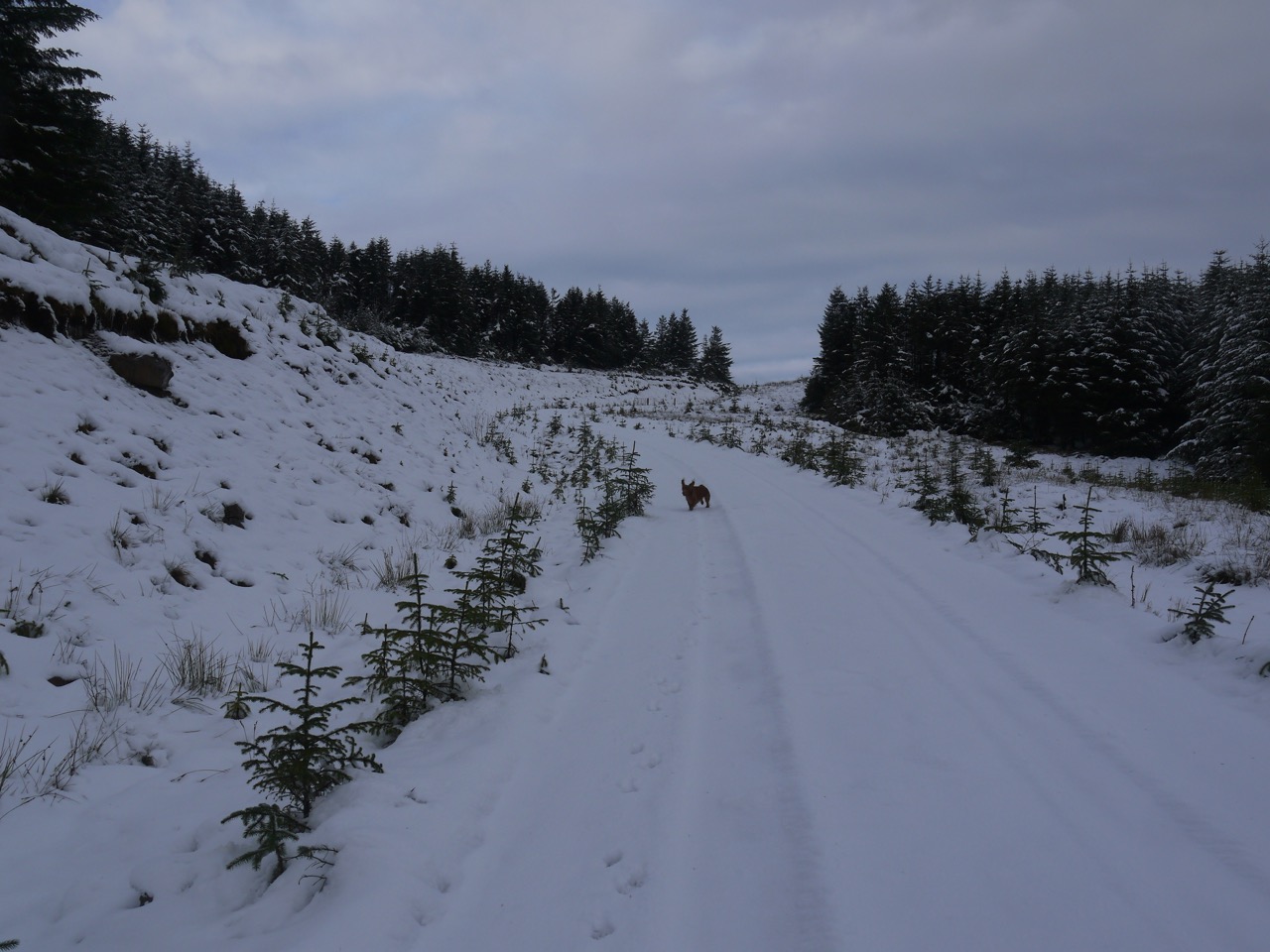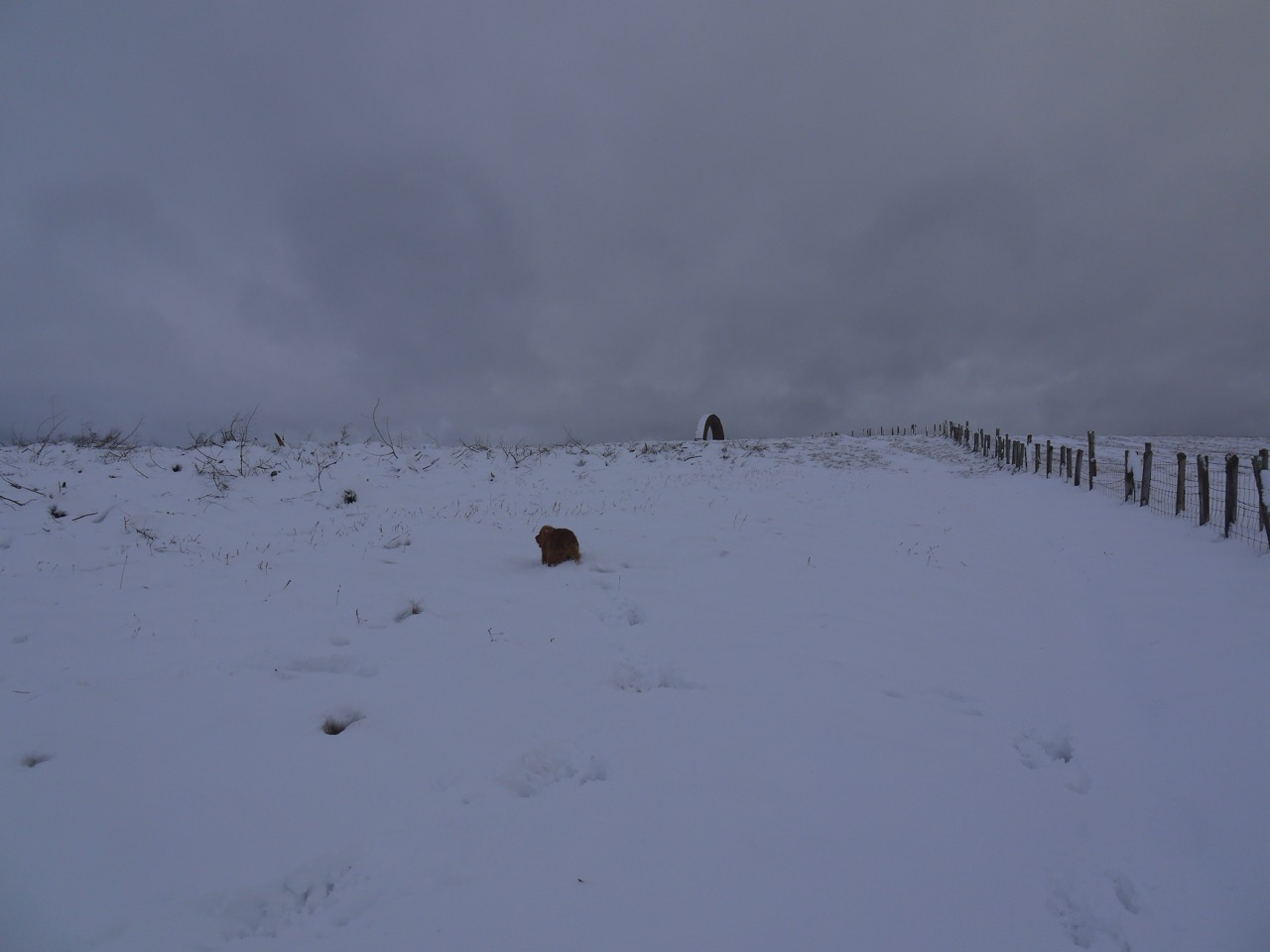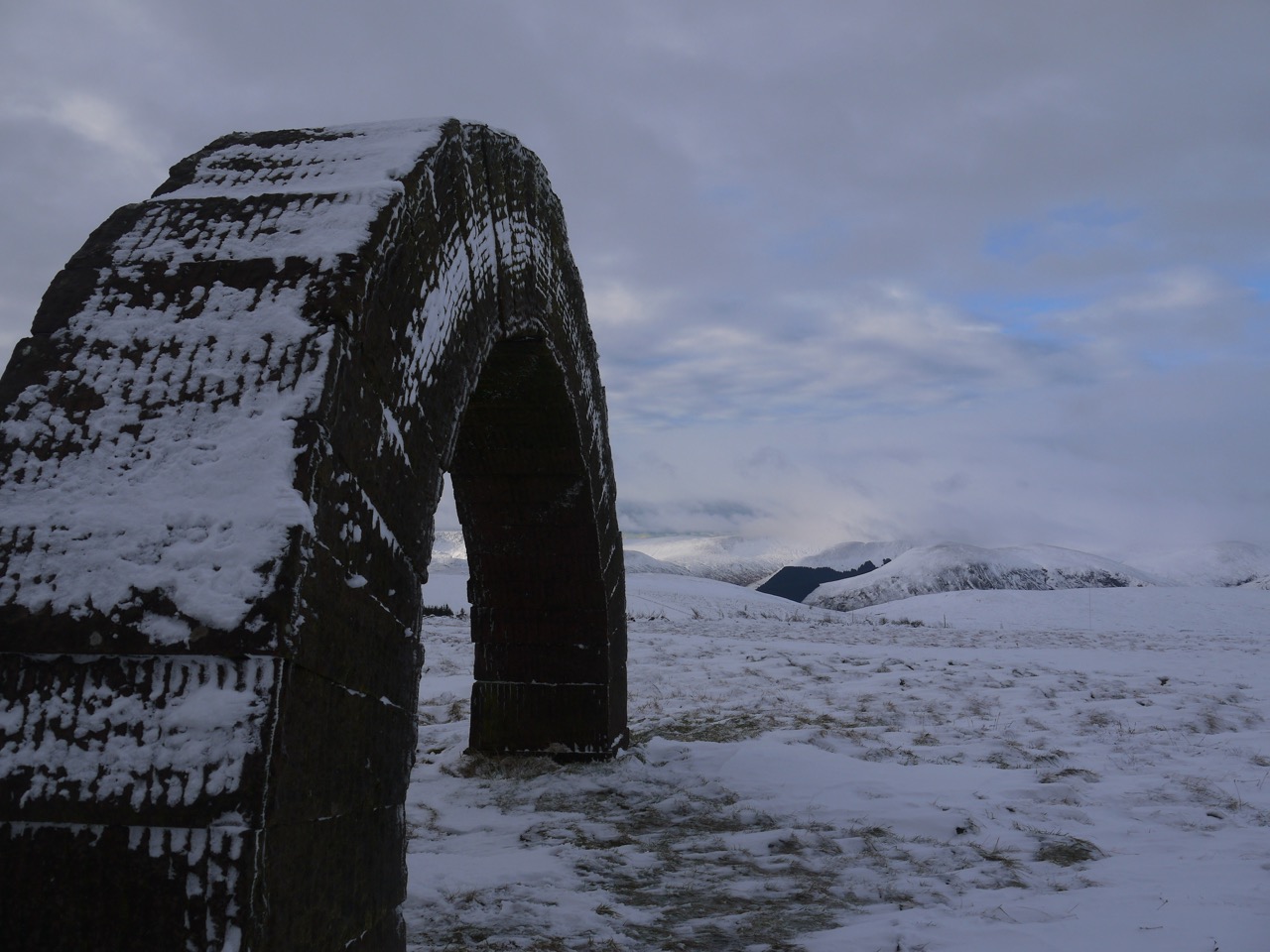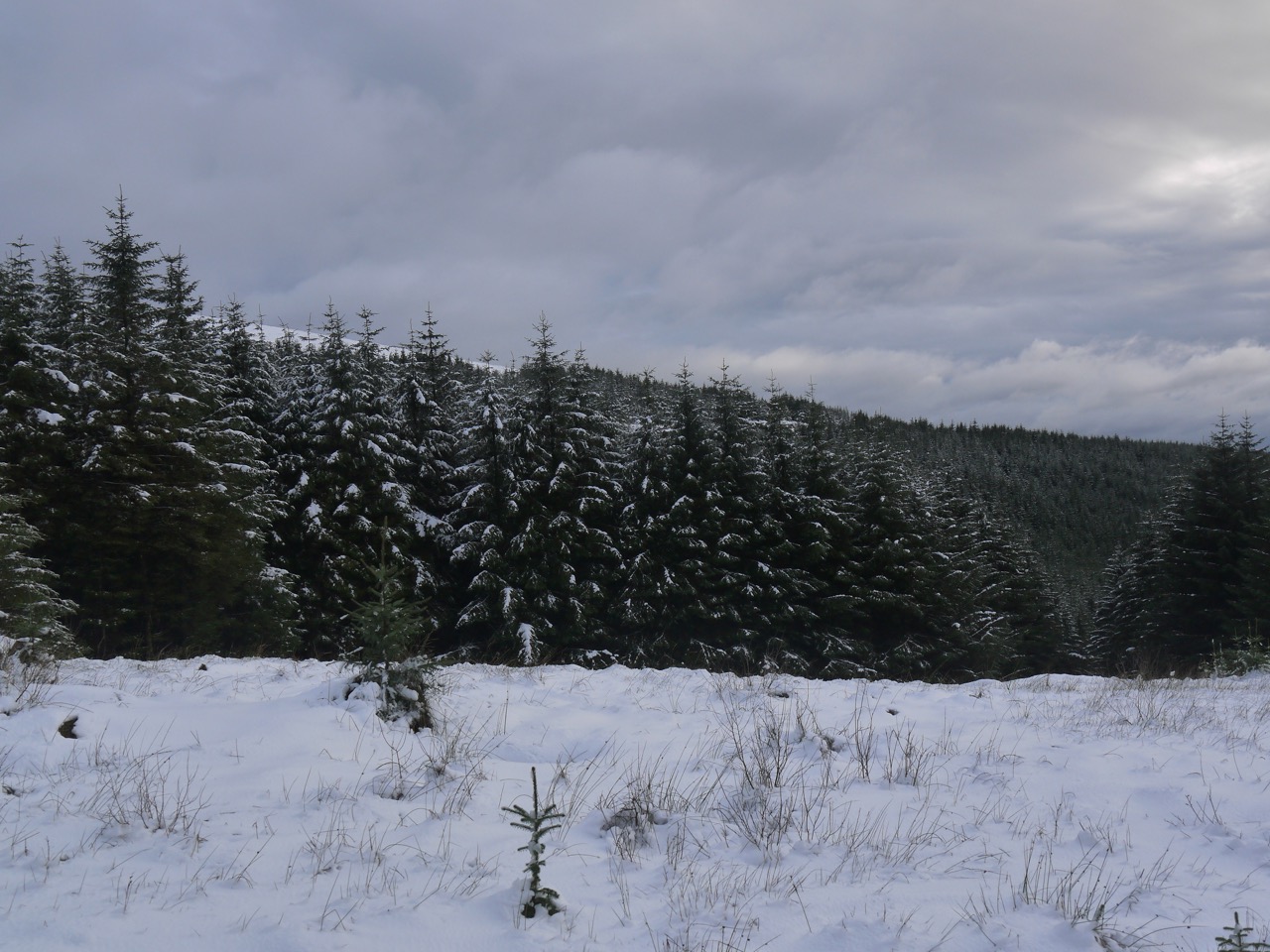5.9 miles 2h 42m 347m ascent
I planned this as a walk up past the Striding Arch on Colt Hill and along to Lamgarroch but conditions meant we turned back at Colt Hill.
The walk began at Cairnhead where the road up from Moniaive, which had already become a rutted track, officially becomes a “no unauthorised entry” forestry track, though the gate stood open. We walked up the short track to visit the Byre, with its sandstone arch passing through a space in the wall where one would expect a gate. What does one call such a gap?
The wall has four sandstone blocks each inscribed with a name and date, presumably the names the place has previously been called: Conraicht 1547, Konrick 1600, Conrig 1804, and Cairnhead 1911.
Within the confines of the ungated wall is a raised platform of paving stones, inscribed with eight names: Arthur Bell, shepherd 1891, Samuel McCall 1871, Elizabeth McVittie 1851, John Fergusson 1851, James Barber 1824, Archibald Wallace 1821, William Riddell 1790, Matho Fergusone 1507.
“Matho Fergusone in Conrig of his 2½ mark land thereof” is mentioned as settling of amounts to the Master of Glencairn in a Council document from 6th Dec 1560, so I presume these names are of previous tenants/owners. The 2½ marks he paid was a tiend, a land tax amounting to one tenth of the expected output of the land that was paid to the church. A group of tenants in this area had “contemptuously refused to obey” orders to pay their taxes forcing William Cunynghame, Master of Glencairn, factor for the Kirk of Glencairn to apply to the Scottish Parliament to obtain letters requiring payment of these Church tiends. The Privy Council in Edinburgh made the order for the defaulters to pay in 1560. Matho Ferguson had 5 marks to pay for 2 years of unpaid taxes.
I haven’t been able to find anything about the other people named.
The Byre at Cairnhead has a sandstone arch passing through an upper window. This was the first of Andrew Goldsworthy’s Striding Arches and was built in 2006. Three others stand on the nearby hills, Benbrack, Bail Hill and Colt Hill, and I believe there are others in the USA and NZ. Each arch is a little “under four metres high, with a span of about seven metres, consisting of 31 blocks of hand-dressed red sandstone weighing approximately 27 tons”. So I doubt they will be stolen. The three hilltop arches can be seen from each other, but from the byre arch one can only see the that on Bail Hill.
Despite visiting this spot several times, I hadn’t previously been into the byre itself, only glimpsed the inside through the windows. I’m pretty sure the door has been locked before, but it was open today so we got to see the inner part of the arch. Having looked around at the carvings and sculptures, and confirmed that we could only see the arch on Bail Hill it was time for some walking.
I didn’t expect any sheep to be roaming about given the weather but there was one and I decided to take a short-cut with Eddie to avoid him noticing it. That meant a slightly steep, slippery descent directly from the Byre Arch to the forestry track rather than following the track itself around.
Once back on the muddy track we strode on up the glen. Autumn had turned down the saturation on the greens but some remnants of nature were still shining through. We passed trees laden with crabapples (both common and siberian), the former were intensely bitter and the latter tasteless, though both had the characteristic apple crunch when bitten. Indeed I heard that crunching sound from nearby and turned to see Eddie spitting out the remnants of an apple. Obviously too sharp for his taste.
Surfing the net for the etymology of crabapple I came across the following paragraph several times, and here it is reproduced again: “The crab apple is actually the wild apple, source of all domestic apples grown today. There are two thoughts about the origin of crab in this sense. The first notes that the Scottish form is scrab or scrabbe, seemingly from a Norse source, as there is Swedish skrabba “fruit of the wild apple tree”. This would suggest that crab and crabbe are aphetic forms of a much older word. The other possibility is that it derives from crabbed, which itself means, etymologically, “crooked or wayward gait of a crab” and the several figurative senses that follow from that (disagreeable, contrary, ill-tempered, or crooked). One of those senses might have been applied to the fruit of the crab apple: not right, not pleasant, ill-flavored (because crab apples are very sour and astringent).”
By the time we crossed the Dalwhat Burn the ground beneath our feet had changed from muddy to frozen, and as we walked on we found ourselves walking on frost and eventually snow deep enough to crunch beneath our feet.
A bitingly cold wind blew directly in our faces as we walked along the forestry track, only letting up after we turned at the small waterfall and walked into the lee of Black Hill. The snow here was a little deeper but the going much easier now we were sheltered from the wind.
Once we reached the col between Black Hill and Colt Hill we were back in the wind and the temperature, or at least our temperatures dropped quickly. We turned up Colt hill which has been denuded of trees since I was last up here. That allowed us better views but unfortunately it left us directly in the wind throughout the climb.
The snow here had either drifted or fallen more heavily. Either way we had to climb the last 100m through knee deep snow. It was a little deeper in places where small hollows were hidden by the snow and I saw Eddie disappear into a couple of these as he bounded up the hill. I had my share and judging be the occasional shriek from behind me, Audrey had not avoided all of them.
At the summit the snow was shallow except where it had drifted. The wind however was both stronger and colder, a classic north wind. The views were surprising good despite the relatively low cloud. We could see Dodd Hill, Moorbrock Hill and Benninner cloaked in snow but Cairnsmore of Carsphairn was lost in cloud.
There was too much snow for us to continue on to Lamgarroch, and it was too cold to hang about at the summit so we headed back down. It was much colder on the descent, presumably since we needed to put in less effort. Poor Eddie was collecting balls of snow in his fur and wasn’t very happy about it, so we pressed on quickly to get out of the deeper snow and away from the north wind.
The walk back down was a lot easier and we warmed up once out of the wind and Eddie was soon back to his usual self exploring the trees beside the track. I had worried that we were in for a chilling once we were back out of the shelter of Black Hill, but it seemed to have relented a little for us.
Given the cold, we had our sandwiches once we got back to the car.
[osmap gpx=”http://www.screel.co.uk/walks/wp-content/uploads/2016/12/RK_gpx-_2016-11-22_1028.gpx”]

